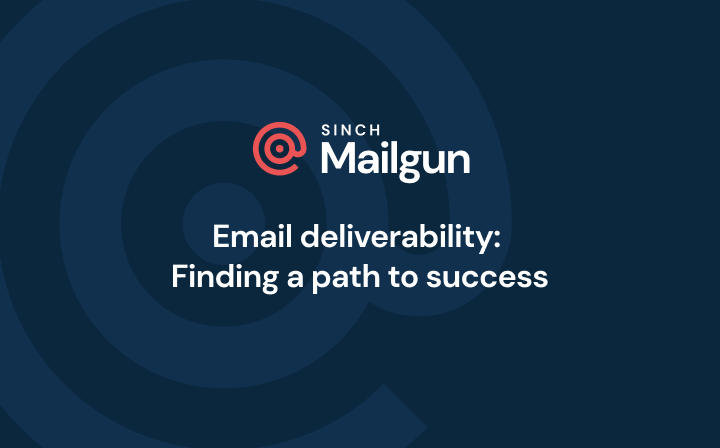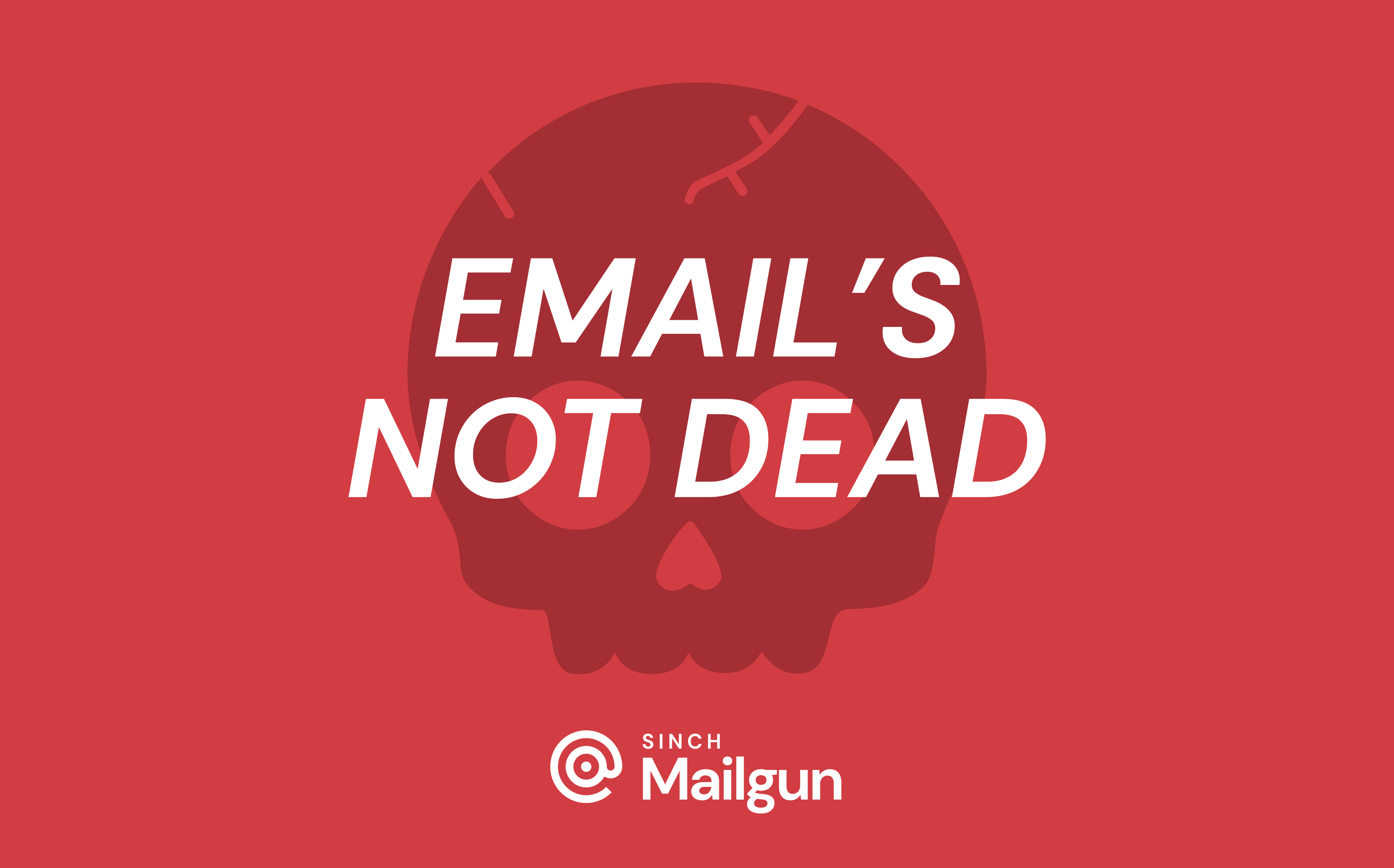Podcasts
Sending emails at the right time with Send Time Optimization
Email’s Not Dead: Season 2, Episode 2
Home
The Mailgun Resource Center
Podcasts
Sending emails at the right time with Send Time Optimization -
Sending emails at the right time with Send Time Optimization
Email's Not Dead
About this episode:
Wait, wait, we have more. In this episode, Mailgun’s Product Manager, Chris Farmer brings you up to speed on how you can send your emails at the right time with Send Time Optimization. Is it better to send in the late morning, early afternoon, or early evening? Tune in now!
PUBLISHED ON
Meet your presenters

Jonathan Torres
Manager of the TAM team at Sinch Mailgun

Eric Trinidad
Technical Account Manager II at Sinch Mailgun

Chris Farmer
Product Manager at Sinch Mailgun
transcript
Email’s Not Dead – S2, E2: Sending emails at the right time with Send Time Optimization
Overview
00:00:05
Eric Trinidad: Welcome to Email’s Not Dead. I'm Eric and this is Jonathan.
00:00:09
Jonathan Torres: Hello.
00:00:09
Eric Trinidad: Thanks for coming back. This is part two of adding tools to your tool chest.
00:00:14
Jonathan Torres: Yes, I like that.
00:00:15
Eric Trinidad: Right, right. Last time we talked about widening the aperture of the sending funnel and making it that sweet, sweet sending cylinder with inbox placement. So we're continuing that off with Send Time Optimization.
00:00:30
Eric Trinidad: Jonathan, hold it together man!
00:00:30
Jonathan Torres: I'm sorry, I'm sorry. That was good. That was really good.
00:00:34
Eric Trinidad: Well, I'm glad you enjoyed it. You know, we have another ear buddy, with us here today, Chris Farmer, one of our product managers here to talk about Send Time Optimization. Say hello to the nice people, Chris.
00:00:44
Chris Farmer: Howdy y'all.
00:00:46
Jonathan Torres: Howdy Chris! I know we normally don't call you Chris, so it's kind of weird. Maybe Christopher.
00:00:53
Chris Farmer: It is weird, I don't even know my first name anymore.
00:00:54
Jonathan Torres: Kristoffersson, is Kristoffersson better?
00:00:58
Chris Farmer: Farmer's good.
00:00:59
Jonathan Torres: We'll stick with Farmer.
00:00:59
Eric Trinidad: Yeah, we'll go back to Farmer. So yeah. So yesterday, well previously we had spoken with Jorge about Inbox Placement and he told us the breakdown of what it is and how we can just use it to work better and help us all the way around. Can you tell us a little bit about what Send Time Optimization is?
00:01:17
Chris Farmer: Yes, a quick definition. It's essentially a machine learning algorithm that we use to analyze engagement data for our recipients. And the way that it works is we send billions of messages a month here on Mailgun across multiple different senders, obviously, and those senders use open and click2 tracking with us. And so we're able to look at the engagement data, the open and click tracking that we have for those recipients over time and see when those recipients are engaging with the messages the most. And so what we do is, if you send a message that has STO enabled for a recipient, we take that recipient address, we check the engagement data that we have on hand for that recipient and we're able to tell if this person engages with the messages around this certain time. And so we'll actually hold on to that message and schedule it for delivery at the most optimal time for that recipient.
00:01:59
Eric Trinidad: Right on. Because I know that's, like, a big question that we always get, you know, during setting up warm up times or just, like, building that consistency, you know, with senders of like, when is the actual best time to send. So this is going to help us out all the way around.
00:02:14
Chris Farmer: Yeah. So marketers are, a lot of times, wondering when the best time is to send out. And most of the time, you know, if you do research on it, you'll find different articles that say, 12 p.m. on a Tuesday or 2 p.m. on a Wednesday or Thursday is the best day. And what marketers do is they take that back and apply it to a segment across all of their recipients, which is taking a solution for a problem and applying that solution across multiple different recipients. But the way that STO works is we actually go look at each recipient individually, because different people have different habits. Right. I might open my emails in the morning before I get to work. Somebody might open their emails at lunchtime. Somebody else might open their emails when they get home from work. So their individual habits, individual people have individual habits and STO strategizes those individual habits into account and schedules the messages for those individual recipients across the campaign.
00:03:05
Chris Farmer: Awesome. I know, that's like for the definition on, we're talking about a lot of stuff that's like, I don't know, kind of technical. And I know we don't necessarily want to get into, like the actual technical right? We don't need to know exactly how it works, what the processes are, what the scripts are behind the scenes that are doing everything. But I mean, getting to know a little bit of that, exactly like what you mentioned there. Right. When is it that I should be getting things through and without having or without a person actually sitting there and setting a time for each and every single person to get a message, like, this is nice. It's a nice way to do some automation behind it, if you will.
00:03:40
Chris Farmer: Yeah, automation is a big time saver. Yeah. Because you're not having to sit down and figure out what the best time is to apply to the different segments. What to do. So you're not worried about having to spend that time to figure those things out. It's a simple, like, send us the API parameter and we'll do all the legwork for you and figure out when the best time is to send for that particular recipient.
00:03:58
Jonathan Torres: Awesome. Awesome. And I know like the way we've looked at it before kind of internally and kind of what we've pitched is kind of like a little bit of a heat map. Right. Of what it looks like for delivery for a user. Right. Like one of those optimal times that they're engaging with a message when it comes through for them. When we go a little bit deeper for that particular person or a particular person, what is it that we're doing is like whenever we go from an individual person and try to decide that there's limits, obviously, that, you know, we can't do it. So let's say like I'm a sender and I'm trying to get all the messages out within a certain time frame, like what are the limitations on how long it's going to sit or how long it's going to wait till I have that opportunity to do so. So is it going to go at like the first opportunity that it gets? Is it going to wait for the total optimal time? Or one of my parameters that I can say of, hey, I really need to get this out, do it as quickly, but as optimally as possible.
00:04:51
Chris Farmer: Yeah. So currently, the way that STO the algorithm works is it looks for hot spots. We do build a heat map based on the engagement data that we have. And so we look for hot spots and we'll choose whatever the hottest spot is and that will pick that time period, that's the hot spot on the heat map. But, you know, going even further than that, when you use STO, you send us a time window. So it's anywhere from 24 hours to 72 hours. You can tell us if you send the window of 24 hours, we'll look at a 24 hour time period beyond the sending times. If you send at noon, we'll look at 24 hours beyond that until tomorrow at noon, and we'll look at engagement data in that window. And that's when we'll determine if there's a hotspot in that time space, we'll actually select that time as the delivery time. If we don't have engagement data for that recipient within that window, then we'll just deliver the message immediately. But yeah, so if customers want to, if senders want to make sure that the messages are out on the same day, so let's say it's noon. They want them sent out by midnight, the same day they can set the time period to 12 hours. And so that time window is the longest period of time that we'll hold on to the message to deliver it. So, if you only want the max amount of time, you wanna hold on to the message... is 12 hours instead of 12 hours, we'll make sure that it's delivered as long as we have data on that time frame. We'll hold on to it up to 12 hours or deliver it immediately if there's no engagement data
00:06:08
Jonathan Torres: That's perfect. Like, when we get to the nitty gritty of it, sometimes things are more time-sensitive, sometimes things are time-sensitive and we want to make sure they're seen. And then obviously, if we want to make sure that it's seen, which is a very nice thing for people to want, you know, and again, breaking it down, I think we mentioned it every single episode so far that like engagement is like such a key thing within the email space. And that's exactly what we're looking for. And getting this to help us optimize for engagement is pretty damn awesome. Like, I really, really like this tool. I really like what it's doing when we start getting into kind of like, I guess the use case for it is really going to be probably marketing. Right. Like we're looking at those marketing type emails. We're not really wanting to use it in most other situations. Right? Reminders and transactional?
00:06:56
Jonathan Torres: Transactional messages is probably not the best idea. Typically speaking, if you're sending transactional messages that are like password resets or receipts or invoices, et cetera, you usually want those delivered immediately. So probably not the best to apply STO to transactional. There are probably use cases where it might make sense, but if you want those messages delivered immediately, then obviously you wouldn't use STO.
00:07:15
Eric Trinidad: Yeah, I usually forget my password like at noon on Tuesdays. You know, that's probably the best time I'm going to look at my email.
00:07:22
Chris Farmer: Definitely not the best use case for that. Marketing emails, totally. Think of it like, I was trying to think of an anecdote for STO and we came up with, you know, if you're in the grocery store. But let's say that the grocery store knows when you shop and they know what you're going to buy and they throw out coupons on a display screen in front of the eggs and they know you're going to buy eggs at noon. And so they throw the coupon out there at noon and you're going to see that coupon because it's tailored to you, right? STO is the same idea. We want to deliver the message when the user is actually engaging with their mailbox. And what it does is, it'll put the message towards the top of the inbox and try to be more visible. And it's kind of a dilator because most marketers know that anytime you can tailor the message around your recipient, you have an increased chance of engaging with that message. And so STO is another way of personalizing those messages to the recipient and delivering them when they're actually going to be in the mailbox and it will be delivered towards the top of the mailbox. It'll be more visible to them.
00:08:23
Jonathan Torres: Yeah. I mean that visibility comes from, like, we would want that and think that we've looked at before. Ah. The fact that one... yes. It's getting there at that optimal time. But the optimal time is just because of the way that a lot of email clients themselves have really taught us to look at messages and how to look at messages in email where, you know, most webmail clients, most phone clients, most everything, every client organizes the mail from the newest to the oldest. So it's like getting in at the top of that, making sure that it's one of the first ones to be clicked on. And most people, you're not going to go out and scroll all the way down and find the oldest new message. I'm going to go from the top down, which is our hopefully optimal spot, right?
00:09:00
Chris Farmer: Yeah. And so what that does is obviously, if you're increasing engagement, then you're increasing open and click rates, which in turn gives you a better ROI. So you'll see more click-throughs onto your website. And speaking of that, you know, we've seen during our beta, we've seen customers on average between 5 and 10 percent uplift in open and click rates. We've seen as high as 20 percent for some of our senders.
00:09:21
Jonathan Torres: Yeah, that's awesome.
00:09:22
Chris Farmer: It's pretty exciting.
00:09:27
Jonathan Torres: That's really cool. I mean, because I think everybody wants to achieve getting... and making sure that they're getting their message delivered, message is being opened and clicked and hopefully that's what the increase of things are and and yeah. Like so if you already have good engagement, I'm sure this can help boost. What if you're on the adverse side of that, like. Right. You're not on the greatest set of engagement, stuff like that. Does it help at all?
00:09:48
Chris Farmer: Yeah, that's a great question. So you all mentioned the sending funnel earlier. I'm sure you've talked about that in the podcast before. So STO sits at the bottom of the sending funnel. So we're kind of making the assumption that you've already done whatever you can to widen the aperture of the funnel at the top, right? So STO is not going to increase delivery or deliverability rates, so delivery means how many messages can I get to the mailbox that I'm sending to. And deliverability means how many messages are getting into the inbox versus the spam folder. And so STO is not going to help with those. But what it will do is as long as you have a good delivery and good deliverability, it'll help improve your engagement rates. So it kind of requires your messages to already be landing in the inbox because otherwise it doesn't matter where. If you're landing in the spam folder, it doesn't matter where it is, right?
00:10:34
Jonathan Torres: They could be there at any time, just depending on when they're going to check that spam folder.
00:10:36
Chris Farmer: Yeah exactly.
00:10:38
Eric Trinidad: So what would it actually see like if it did go to spam? I guess the opening in spam, I guess it really doesn't matter, right?
00:10:44
Jonathan Torres: Well, yeah. I mean, when we talk about, like, the technical aspect of that, if it's in the spam folder, unless they click on something where we can actually track that data, that's the only time we'll actually see anything. Otherwise, they would have to move it to a folder that's going to allow a message to fully load up because a lot of times spam folders are just going to do text only versions of the email.
00:11:02
Chris Farmer: Yeah, the majority of spam folders are not going to load images, so you wouldn't get those open rates.
00:11:06
Jonathan Torres: Right. Exactly. Yeah. That definitely impacts the open rates because that's the way we track. Right. Like everybody, hopefully everybody within the industry knows and understands that we're putting you know, usually a one by one pixel without any kind of content that's going to be hidden within the message or quote unquote, hidden within the message. Right. And when it loads up, that image we'll be able to see it. But if it's in the spam folder, we're not going to get any of that data. So, heck, they may be opening it and they may be seeing it right away, but we're not going to know that until they pull that message out of the spam folder, which is hopefully what they're going to do and hopefully what we're trying to achieve anyway, when we talk about overall deliverability and making sure that things are good within deliverability space. Back to the point. Which is that, you know, even if we are getting in the optimal time within the spam filter, it's still within the spam folder and not really helping us out in the long run. But that's awesome stuff. Like, I know this is going to be a little bit diverting from some of this, but I want to get some more information. Like so, like when we're looking at the big picture of things and particularly you and your role. First of all, all of us in this room have the benefit of knowing you for a while now, being friends at least, I would like to think that we're friends.
00:12:15
Eric Trinidad: We're acquaintances for sure. I mean, like, you don't wish harm on me. I don't think.
00:12:22
Jonathan Torres: We at least would live within that space. So I know and from what I understand of your role overall. Right. Part of what you're doing is getting the right things in line, the right way to put those things in front of the customer.
00:12:36
Chris Farmer: Yeah.
00:12:36
Jonathan Torres: The things that customers are asking for, the things that we know will help a customer out and kind of things like that. So, I mean, I don't know if it's your woodworking skills that help out with that or, you know, your love of alcoholic beverages and that collection, that beautiful bar that you're making. But that's kind of you know what? I don't know. I think the... life experiences like, you know, help build on that. And granted, like, we don't need to go over all your life experiences, but when you're looking at this stuff like what is it that you've seen people have asked for? What is that feedback that we've gotten from customers on this and what you've been able to filter out and kind of bubble up and maybe things that you've contributed into this that you've seen are important for our customers, are important for the tool to have, are important for like? What is the meat and potatoes? Is it just getting it there on time or is there anything that's a little bit more that's a little bit deeper that maybe people aren't thinking about whenever you think of a simple tool like this, or what could seem like a simple tool.
00:13:32
Chris Farmer: Yeah, I mean, I think there's different aspects of what products and features to build. There's the aspect of, you know, what our customers want or what our customers are missing. You know, if they're coming to us from other competitors, what are the gaps that we don't have or what are the gaps that, you know, one of the things that we have that they don't have, but also how can we help streamline their businesses? How can we make them more efficient at what they do? And so, like from a product manager's perspective, a lot of it is like sitting down with the customer and walking them through or walking through what their day to day lives are and using an ESP like Mailgun and then talking about what are their pain points and what are they where do they want to go. And then based on those conversations and you start talking about like, well, how can we solve for those pain points? And that's where a lot of these things like STO come up. You know, a STO actually came about like we started analyzing data sets for the engagements that we had. What we did is we looked at heat maps for the majority. So we took all the messages that we delivered and looked at. We built a heat map on what times we normally deliver those messages. And then at the same time, we also built heat maps for open and click data. And we were able to see that there was a discrepancy between the time that the majority of the messages were delivered versus the time that most of the messages were engaged with. And the idea with STO was to kind of merge those together. And then if we merge those together, then there was likely going to be that engagement, rates were going to be higher. And during testing that was the case. So, yeah, a lot of product management is just understanding what gaps there are for customers, what pain points there are, and then what can we build to help solve those paint points.
00:15:01
Jonathan Torres: Yeah, close the gap.
00:15:03
Chris Farmer: Yeah,
00:15:04
Eric Trinidad: Close the gap, but also widening the aperture. Close but also wider.
00:15:10
Jonathan Torres: Close the gap to widen the aperture? Is that it?
00:15:14
Eric Trinidad: Same, same but different. You know?
00:15:20
Jonathan Torres: Yeah, that's perfect. I mean that's exactly what. I guess I bring it up to kind of show that we're just not doing nothing about not doing nothing. I don't know how to phrase that.
00:15:30
Eric Trinidad: We're taking your feedback, but we're listening to you as things, we are paying attention to the data that we have. I mean. We're looking at ways that we can, like, best help you as customers and help y'all be not only just good customers, but be successful. Because when y'all succeed, we succeed.
00:15:46
Chris Farmer: Absolutely.
00:15:47
Eric Trinidad: Yeah, absolutely guys.
00:15:48
Jonathan Torres: Yeah. So and that's what I appreciate from you Farmer overall, me, myself, personally. I don't want to speak for anybody else, but I think the appreciation would go, you know, further and beyond, because sometimes I think we think we know and we get feedback and maybe we don't exactly know, but maybe that feedback is there and that feedback needs to be filtered a little bit and kind of, you know, marinaded, if you will. You also do some cooking stuff don't you?.
00:16:10
Jonathan Torres: Yeah.
00:16:10
Eric Trinidad: And a nice souvee. You know.
00:16:14
Jonathan Torres: I've had the brisket before.
00:16:19
Chris Farmer: It's tough to make decisions in a vacuum. And that's why we talk to a lot of customers to get feedback on, like, you know, gather requirements, what are the requirements for all these things. So without customer feedback, we would just be building things that nobody cared about. So it's important to get customer feedback and learn how they want to use the product to learn what kind of things they want to see to help the experience, help the experience be better.
00:16:38
Jonathan Torres: Yeah, that's awesome. That's perfect and that's when we can make the experience better. We can make the product work better. We can close the gap, widen the aperture. I think everybody's happy or hopefully or happier than they were before. Hopefully. That's awesome. Perfect.
00:16:52
Eric Trinidad: Well Farmer thank you again. Really appreciate all your hard work and your time. And thanks for hanging out with us today.
00:16:59
Chris Farmer: Absolutely. Thank you.
00:17:00
Eric Trinidad: Yeah. Please, if you ever want to come back or want to chat with us or you know, tell us about either some new projects that are coming up, some new beverages that you're working on or the bar. How's that doing? I love hearing about it, but also for everybody else, please stay tuned for this upcoming season of Email’s Not Dead. You know, we're continuing on fully strong. I'm looking at Thomas. Yes, okay. Yes, yeah. Please also look at our blog posts. Look at the updates, Send Time Optimization. When is that available, sir?
00:17:32
Chris Farmer: Now.
00:17:32
Eric Trinidad: Now, right now.
00:17:33
Chris Farmer: Scale and custom plans. Check them out at Mailgun.com/pricing.
00:17:39
Eric Trinidad: Nice.
00:17:40
Jonathan Torres: And then for the individual products, you write
and
00:17:48
Eric Trinidad: Right on. Well, again, thank you everybody for joining us. And until next time, we'll check ya later.




